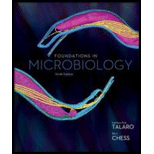
Concept explainers
What do you suppose the world would be like if there were cures for all infectious diseases and a means to destroy all microbes? What characteristics of microbes would prevent this from happening?
To analyze:
- The scenario if cures for all infectious diseases were found and all microbes could be destroyed.
- The characteristics of microbes that would prevent such a situation from happening.
Introduction:
Infectious diseases caused by micro-organisms are a cause of widespread mortality and morbidity. While some infectious diseases have been eradicated because of vaccination and antibiotics, many others still continue to prevail. Currently, almost 2000 different pathogens infect humans and cause diseases, and more than 10 billion infections are reported across the globe, each year. This is because antibiotics are ineffective against many micro-organisms. Such micro-organisms have devised strategies to counteract the effect of antibiotics, and are causing infections in humans.
Explanation of Solution
If we imagine a scenario where cures for all infectious diseases have been found, there would be a significant increase in the lifespan of humans. Consequently, humans will over-populate the earth and cause a tremendous pressure on natural resources. If all microbes would be destroyed, there would be drastic changes in ecosystems and natural processes. The oxygen content in the atmosphere would reduce to critical levels, because of absence of photosynthesizing bacteria. Decomposition and mineral recycling will cease, thereby making elements inaccessible to humans and plants. The levels of greenhouse gases like carbon dioxide and methane would go down, and this would make the temperature of the earth fall down severely. All these changes would in turn make earth inhabitable for humans, and threaten their existence.
The immense resistance of micro-organisms gives them the ability to thrive under extremes of temperature, salt content and pH, and in toxic wastelands, radioactive areas and even in volcanoes. They are able to adapt quickly and become drug-resistant, thereby making it difficult for us to destroy them.
Want to see more full solutions like this?
Chapter 1 Solutions
Foundations in Microbiology
- What microbial structures are the most resilient forms of life? Bacterial endospores Enveloped viruses Fungal spores Gram-positive bacteriaarrow_forwardInfectious diseases can be caused and spread by all manner of living and non living things. Which group of microbes seems to be the worst? Why?arrow_forwardRefrigerated milk can spoil due to microbial growth. Do these microbes typically cause disease in humans? Consider the environment in your body and the environment in which the microbes are growing.arrow_forward
- What statement describes the danger of using heavy metals to control microbe growth? Group of answer choices Heavy metals promote biofilm formation in humans. Heavy metals stimulate some microbes to reproduce even more. Heavy metals can assist with virus attachment to host cells. Heavy metals are toxic to many organisms besides microbes.arrow_forwardWhat does it mean to say microbes are ubiquitous?arrow_forwardHow is bacteria different/distinct from all other microbes and organisms for that matter?arrow_forward
- two ways bacteria are harmful and two ways they are helpful to humans?arrow_forwardWhat is the ultimate way that microbes will, as Pasteur said, have the“last word”?arrow_forwardWhen food leftovers are stored in a refrigerator, how does this help prevent food borne illnesses? Group of answer choices Low temperatures deactivate any toxins that might be produced by microbes. Low temperatures inhibit the metabolism and growth of microbes. Low temperatures disrupt microbe membranes and kill any microbes that are present. Low temperatures prevent microbes from forming biofilms.arrow_forward
- which of the following definitions is not technically correct? a. broad spectrum - effective against many different types of microbes b. bacteriostatic - prevents microbes from growing c. antibiotic - microbial or synthetic product that kills or inhibits growth of microbes. d. all of the above are correctarrow_forwardWhy can't bacteria be harmful?arrow_forwardThere are estimates that the microorganisms present in the human body outnumber the cells of the body. Which of the following is incorrect about microbes (normal flora )? a. • Compete with other microbes for space by colonizing the surface of the human body • b. Toxins produce to inhibit the growth of other pathogens - c .compete with other microorganisms for nutrition. d. Neutrophils activate to act against other pathogensarrow_forward
 Concepts of BiologyBiologyISBN:9781938168116Author:Samantha Fowler, Rebecca Roush, James WisePublisher:OpenStax College
Concepts of BiologyBiologyISBN:9781938168116Author:Samantha Fowler, Rebecca Roush, James WisePublisher:OpenStax College
